Small overlap front: driver-side
Rating applies to 2017-25 models built after August 2016
Tested vehicle: 2017 Chrysler Pacifica Touring
The Chrysler Pacifica was introduced in the 2017 model year as a replacement for the Chrysler Town and Country minivan. The Chrysler Voyager, available new only to fleet buyers, was introduced in the 2020 model year and shares the same platform as the Pacifica.
Two tests of the Pacifica were conducted because the driver door was torn off its hinges in the first test. As a result, Fiat Chrysler strengthened the upper hinge and reinforced the joint between the door hinge pillar and inner body panel in front of the pillar. In the second test, the upper hinge held and the door stayed shut.
The small overlap frontal ratings listed below apply only to vehicles built after August 2016, that is after the door hinge improvements were made. (Information about when a specific vehicle was manufactured is on the certification label typically affixed to the car on the driver door or adjacent B-pillar.)
| Evaluation criteria | Rating |
|---|---|
| Structure and safety cage | |
| Driver injury measures | |
| Head/neck | |
| Chest | |
| Hip/thigh | |
| Lower leg/foot | |
| Driver restraints and dummy kinematics | |
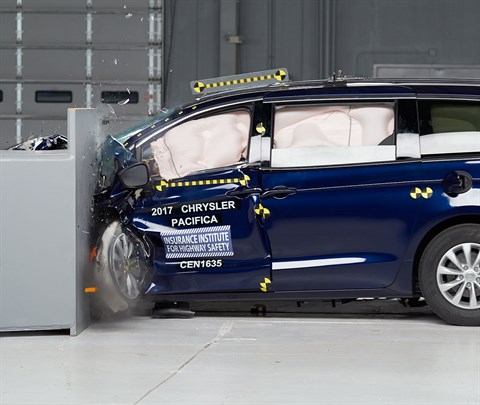
Action shot taken during the driver-side small overlap frontal crash test of the 2017 Chrysler Pacifica built after August 2016.
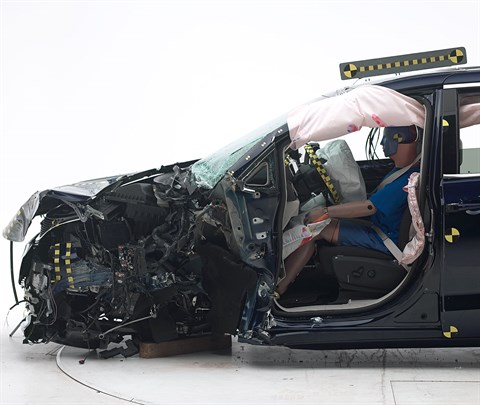
The dummy's position in relation to the door frame, steering wheel, and instrument panel after the crash test indicates that the driver's survival space was maintained reasonably well.
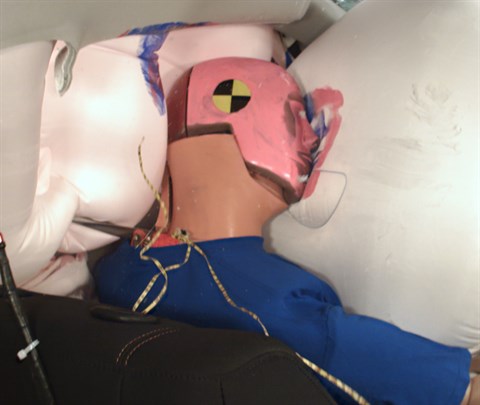
The frontal and side curtain airbags worked well together to keep the head from coming close to any stiff structure or outside objects that could cause injury.
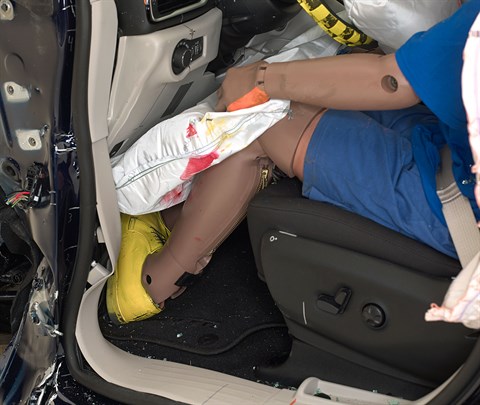
The driver's space was maintained reasonably well, and risk of injuries to the dummy's legs and feet was low.
Measures of occupant compartment intrusion on driver side
| Evaluation criteria | Measurement |
|---|---|
| Test ID | CEN1635 |
| Lower occupant compartment | |
| Lower hinge pillar max (cm) | 12 |
| Footrest (cm) | 14 |
| Left toepan (cm) | 11 |
| Brake pedal (cm) | 5 |
| Parking brake (cm) | |
| Rocker panel lateral average (cm) | 4 |
| Upper occupant compartment | |
| Steering column | 2 |
| Upper hinge pillar max (cm) | 7 |
| Upper dash (cm) | 8 |
| Lower instrument panel (cm) | 9 |
Driver injury measures
| Evaluation criteria | Measurement |
|---|---|
| Test ID | CEN1635 |
| Head | |
| HIC-15 | 71 |
| Peak gs at hard contact | no contact |
| Neck | |
| Tension (kN) | 0.8 |
| Extension bending moment (Nm) | 8 |
| Maximum Nij | 0.18 |
| Chest maximum compression (mm) | 20 |
| Femur (kN) | |
| Left | 1.2 |
| Right | 0.8 |
| Knee displacement (mm) | |
| Left | 2 |
| Right | 1 |
| Knee-thigh-hip injury risk (%) | |
| Left | 0 |
| Right | 0 |
| Maximum tibia index | |
| Left | 0.73 |
| Right | 0.31 |
| Tibia axial force (kN) | |
| Left | 2.2 |
| Right | 1.7 |
| Foot acceleration (g) | |
| Left | 45 |
| Right | 28 |
Small overlap front: passenger-side
Rating applies to 2020-25 models built after August 2020
Tested vehicle: 2020 Chrysler Pacifica Touring Plus 4-door
The Chrysler Pacifica was introduced in the 2017 model year as a replacement for the Chrysler Town and Country minivan. The Chrysler Voyager, available new only to fleet buyers, was introduced in the 2020 model year and shares the same platform as the Pacifica.
Beginning with 2020 models built after August 2020, the passenger front door hinge pillar, A-pillar and door sill was strengthened to improve occupant protection in passenger-side small overlap frontal crashes. (Information about when a specific vehicle was manufactured is on the certification label typically affixed to the car on the driver door or adjacent B-pillar.)
Passenger-side small overlap frontal ratings are assigned by the Institute based on a test of a 2020 Chrysler Pacificia conducted by Fiat Chrysler.
| Evaluation criteria | Rating |
|---|---|
| Overall evaluation | |
| Structure and safety cage | |
| Passenger injury measures | |
| Head/neck | |
| Chest | |
| Hip/thigh | |
| Lower leg/foot | |
| Passenger restraints and dummy kinematics | |
| Driver injury measures | |
| Head/neck | |
| Chest | |
| Hip/thigh | |
| Lower leg/foot | |
| Driver restraints and dummy kinematics | |
Measures of occupant compartment intrusion on passenger side
| Evaluation criteria | Measurement |
|---|---|
| Test ID | VTP2013 |
| Lower occupant compartment | |
| Lower hinge pillar max (cm) | 11 |
| Footrest (cm) | 15 |
| Right toepan (cm) | 9 |
| Center toepan (cm) | 2 |
| Rocker panel lateral average (cm) | 3 |
| Upper occupant compartment | |
| Center dash (cm) | 5 |
| Upper hinge pillar max (cm) | 5 |
| Upper dash (cm) | 7 |
| Right lower dash (cm) | 7 |
Passenger injury measures
| Evaluation criteria | Measurement |
|---|---|
| Test ID | VTP2013 |
| Head | |
| HIC-15 | 55 |
| Peak gs at hard contact | no contact |
| Neck | |
| Tension (kN) | 1.0 |
| Extension bending moment (Nm) | 9 |
| Maximum Nij | 0.21 |
| Chest maximum compression (mm) | 23 |
| Femur (kN) | |
| Left | 1.6 |
| Right | 1.7 |
| Knee displacement (mm) | |
| Left | 3 |
| Right | 4 |
| Knee-thigh-hip injury risk (%) | |
| Left | 0 |
| Right | 0 |
| Maximum tibia index | |
| Left | 0.45 |
| Right | 0.48 |
| Tibia axial force (kN) | |
| Left | 2.8 |
| Right | 1.9 |
| Foot acceleration (g) | |
| Left | 36 |
| Right | 33 |
Driver injury measures
| Evaluation criteria | Measurement |
|---|---|
| Test ID | VTP2013 |
| Head | |
| HIC-15 | 36 |
| Peak gs at hard contact | no contact |
| Neck | |
| Tension (kN) | 0.9 |
| Extension bending moment (Nm) | 7 |
| Maximum Nij | 0.14 |
| Chest maximum compression (mm) | 29 |
| Femur (kN) | |
| Left | 0.1 |
| Right | 0.3 |
| Knee displacement (mm) | |
| Left | 0 |
| Right | 0 |
| Knee-thigh-hip injury risk (%) | |
| Left | 0 |
| Right | 0 |
| Maximum tibia index | |
| Left | 0.40 |
| Right | 0.34 |
| Tibia axial force (kN) | |
| Left | 0.5 |
| Right | 0.3 |
| Foot acceleration (g) | |
| Left | 37 |
| Right | 28 |
Rating applies to 2017-20 models built after August 2016 and before September 2020
Tested vehicle: 2018 Chrysler Pacifica L 4-door
The Chrysler Pacifica was introduced in the 2017 model year as a replacement for the Chrysler Town and Country minivan. The Chrysler Voyager was introduced in the 2020 model year and shares the same platform as the Pacifica.
Beginning with 2017 models built after August 2016, the upper hinge of both the driver and front passenger doors was strengthened and the joint between the door hinge pillar and inner body panel in front of the pillar was reinforced. (Information about when a specific vehicle was manufactured is on the certification label typically affixed to the car on the driver door or adjacent B-pillar.)
Two passenger-side small overlap frontal tests of the Pacifica were conducted, one by the Institute and the other by Fiat Chrysler. Ratings are based on both tests.
| Evaluation criteria | Rating |
|---|---|
| Overall evaluation | |
| Structure and safety cage | |
| Passenger injury measures | |
| Head/neck | |
| Chest | |
| Hip/thigh | |
| Lower leg/foot | |
| Passenger restraints and dummy kinematics | |
| Driver injury measures | |
| Head/neck | |
| Chest | |
| Hip/thigh | |
| Lower leg/foot | |
| Driver restraints and dummy kinematics | |

Action shot taken during the Institute's passenger-side small overlap frontal crash test.

The dummy's position in relation to the door frame and dashboard after the crash test indicates that the passenger's survival space was not maintained well (Institute test car shown).
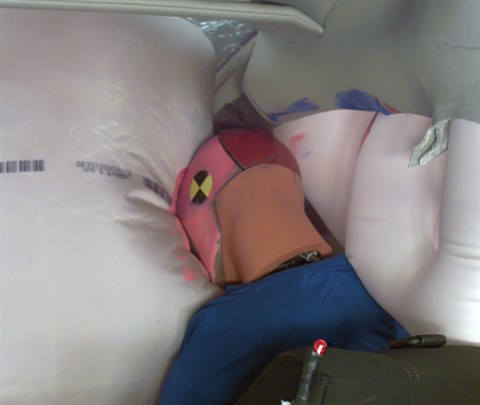
The frontal and side curtain airbags worked well together to keep the head from coming close to any stiff structure or outside objects that could cause injury (Institute test shown).

Despite intrusion of the door hinge pillar and dashboard in both tests, risk of injuries to the dummy's legs and feet was low.
Measures of occupant compartment intrusion on passenger side
| Evaluation criteria | Measurement | |
|---|---|---|
| Test ID | VTP1808 | CEP1816 |
| Lower occupant compartment | ||
| Lower hinge pillar max (cm) | 16 | 17 |
| Footrest (cm) | 16 | 17 |
| Right toepan (cm) | 10 | 11 |
| Center toepan (cm) | 4 | 3 |
| Rocker panel lateral average (cm) | 4 | 4 |
| Upper occupant compartment | ||
| Center dash (cm) | 9 | 10 |
| Upper hinge pillar max (cm) | 10 | 8 |
| Upper dash (cm) | 13 | 13 |
| Right lower dash (cm) | 14 | 13 |
Passenger injury measures
| Evaluation criteria | Measurement | |
|---|---|---|
| Test ID | VTP1808 | CEP1816 |
| Head | ||
| HIC-15 | 72 | 90 |
| Peak gs at hard contact | no contact | no contact |
| Neck | ||
| Tension (kN) | 0.8 | 1.0 |
| Extension bending moment (Nm) | 20 | 9 |
| Maximum Nij | 0.23 | 0.19 |
| Chest maximum compression (mm) | 21 | 19 |
| Femur (kN) | ||
| Left | 2.2 | 1.6 |
| Right | 2.4 | 1.9 |
| Knee displacement (mm) | ||
| Left | 4 | 3 |
| Right | 6 | 6 |
| Knee-thigh-hip injury risk (%) | ||
| Left | 0 | 0 |
| Right | 0 | 0 |
| Maximum tibia index | ||
| Left | 0.49 | 0.54 |
| Right | 0.56 | 0.53 |
| Tibia axial force (kN) | ||
| Left | 2.5 | 2.0 |
| Right | 2.2 | 2.1 |
| Foot acceleration (g) | ||
| Left | 34 | 31 |
| Right | 43 | 26 |
Driver injury measures
| Evaluation criteria | Measurement | |
|---|---|---|
| Test ID | VTP1808 | CEP1816 |
| Head | ||
| HIC-15 | 40 | 47 |
| Peak gs at hard contact | no contact | no contact |
| Neck | ||
| Tension (kN) | 1.3 | 1.1 |
| Extension bending moment (Nm) | 13 | 14 |
| Maximum Nij | 0.22 | 0.22 |
| Chest maximum compression (mm) | 23 | 25 |
| Femur (kN) | ||
| Left | 0.6 | 0.6 |
| Right | 0.2 | 0.1 |
| Knee displacement (mm) | ||
| Left | 0 | 2 |
| Right | 0 | 1 |
| Knee-thigh-hip injury risk (%) | ||
| Left | 0 | 0 |
| Right | 0 | 0 |
| Maximum tibia index | ||
| Left | 0.34 | 0.39 |
| Right | 0.32 | 0.38 |
| Tibia axial force (kN) | ||
| Left | 1.3 | 1.3 |
| Right | 0.5 | 0.7 |
| Foot acceleration (g) | ||
| Left | 21 | 23 |
| Right | 39 | 38 |
Moderate overlap front: original test
Rating applies to 2017-25 models
Tested vehicle: 2017 Chrysler Pacifica Touring
The Chrysler Pacifica was introduced in the 2017 model year as a replacement for the Chrysler Town and Country minivan. The Chrysler Voyager, available new only to fleet buyers, was introduced in the 2020 model year and shares the same platform as the Pacifica. Moderate overlap frontal ratings are assigned by the Institute based on a test conducted by Fiat Chrysler.
| Evaluation criteria | Rating |
|---|---|
| Overall evaluation | |
| Structure and safety cage | |
| Driver injury measures | |
| Head/neck | |
| Chest | |
| Leg/foot, left | |
| Leg/foot, right | |
| Driver restraints and dummy kinematics | |
Measures of occupant compartment intrusion on driver side
| Evaluation criteria | Measurement |
|---|---|
| Test ID | VTF1615 |
| Footwell intrusion | |
| Footrest (cm) | 10 |
| Left (cm) | 15 |
| Center (cm) | 16 |
| Right (cm) | 16 |
| Brake pedal (cm) | 9 |
| Instrument panel rearward movement | |
| Left (cm) | 1 |
| Right (cm) | 1 |
| Steering column movement | |
| Upward (cm) | -4 |
| Rearward (cm) | -6 |
| A-pillar rearward movement (cm) | 0 |
Driver injury measures
| Evaluation criteria | Measurement |
|---|---|
| Test ID | VTF1615 |
| Head | |
| HIC-15 | 151 |
| Peak gs at hard contact | no contact |
| Neck | |
| Tension (kN) | 1.0 |
| Extension bending moment (Nm) | 14 |
| Maximum Nij | 0.20 |
| Chest maximum compression (mm) | 31 |
| Legs | |
| Femur force - left (kN) | 0.3 |
| Femur force - right (kN) | 0.0 |
| Knee displacement - left (mm) | 1 |
| Knee displacement - right (mm) | 0 |
| Maximum tibia index - left | 0.68 |
| Maximum tibia index - right | 0.53 |
| Tibia axial force - left (kN) | 1.6 |
| Tibia axial force - right (kN) | 2.0 |
| Foot acceleration (g) | |
| Left | 69 |
| Right | 82 |
Side: original test
Rating applies to 2017-23 models
Tested vehicle: 2017 Chrysler Pacifica Touring
The Chrysler Pacifica was introduced in the 2017 model year as a replacement for the Chrysler Town and Country minivan. The Chrysler Voyager, available new only to fleet buyers, was introduced in the 2020 model year and shares the same platform as the Pacifica. Side ratings are assigned by the Institute based on a test conducted by Fiat Chrysler.
| Evaluation criteria | Rating |
|---|---|
| Overall evaluation | |
| Structure and safety cage | |
| Driver injury measures | |
| Head/neck | |
| Torso | |
| Pelvis/leg | |
| Driver head protection | |
| Rear passenger injury measures | |
| Head/neck | |
| Torso | |
| Pelvis/leg | |
| Rear passenger head protection | |
Measures of occupant compartment intrusion on driver side
| Test ID | VTS1613 |
|---|---|
| B-pillar to longitudinal centerline of driver's seat (cm) | -19.5 |
| Negative numbers indicate the amount by which the crush stopped short of the seat centerline. | |
Driver injury measures
| Evaluation criteria | Measurement |
|---|---|
| Test ID | VTS1613 |
| Head HIC-15 | 237 |
| Neck | |
| Tension (kN) | 1.3 |
| Compression (kN) | 0.2 |
| Shoulder | |
| Lateral deflection (mm) | 20 |
| Lateral force (kN) | 1.2 |
| Torso | |
| Maximum deflection (mm) | 32 |
| Average deflection (mm) | 27 |
| Maximum deflection rate (m/s) | 2.61 |
| Maximum viscous criterion (m/s) | 0.35 |
| Pelvis | |
| Iliac force (kN) | 1.2 |
| Acetabulum force (kN) | 1.5 |
| Combined force (kN) | 2.7 |
| Left femur | |
| L-M force (kN) | 1.0 |
| L-M moment (Nm) | 150 |
| A-P moment (Nm) | 27 |
Passenger injury measures
| Evaluation criteria | Measurement |
|---|---|
| Test ID | VTS1613 |
| Head HIC-15 | 55 |
| Neck | |
| Tension (kN) | 0.2 |
| Compression (kN) | 0.6 |
| Shoulder | |
| Lateral deflection (mm) | 25 |
| Lateral force (kN) | 1.3 |
| Torso | |
| Maximum deflection (mm) | 30 |
| Average deflection (mm) | 16 |
| Maximum deflection rate (m/s) | 2.85 |
| Maximum viscous criterion (m/s) | 0.32 |
| Pelvis | |
| Iliac force (kN) | 1.8 |
| Acetabulum force (kN) | 2.8 |
| Combined force (kN) | 3.8 |
| Left femur | |
| L-M force (kN) | 0.5 |
| L-M moment (Nm) | 98 |
| A-P moment (Nm) | 41 |
Roof strength
Rating applies to 2017-23 models
Tested vehicle: 2017 Chrysler Pacifica Touring
Ratings apply to the Chrysler Pacifica (tested) and the structurally similar Chrysler Voyager.
| Overall evaluation | |
|---|---|
| Curb weight | 4,378 lbs |
| Peak force | 20,056 lbs |
| Strength-to-weight ratio | 4.58 |
Head restraints & seats
Seat type: Power cloth seat
| Overall evaluation | |
|---|---|
| Dynamic rating | |
| Seat/head restraint geometry |
| Seat type | Power cloth seat |
|---|---|
| Geometry | |
| Backset (mm) | 12 |
| Distance below top of head (mm) | 14 |
| Seat design parameters | |
| Pass/fail | Pass |
| Max T1 acceleration (g) | 10.8 |
| Head contact time (ms) | 49 |
| Force rating | 1 |
| Neck forces | |
| Max neck shear force (N) | 0 |
| Max neck tension (N) | 290 |
About the head restraint & seat test
Currently, IIHS tests apply only to front seats.
Headlights
Ratings are given for 4 different headlight variations available on this vehicle.
Trim level(s)
- Limited trim equipped with Advanced SafetyTec package
- Red S Edition trim
| Evaluation criteria | Rating |
|---|---|
| Low-beam headlight type | HID projector |
| High-beam headlight type | Halogen reflector |
| Curve-adaptive? | No |
| High-beam assist? | Yes |
|
Overall rating | |
| Distance at which headlights provide at least 5 lux illumination: | |
Low beams
On the straightaway, visibility was fair on both sides of the road. On curves, visibility was fair on the sharp left and both right curves and inadequate on the gradual left curve.
The low beams never exceeded glare limits.
High beams
On the straightaway, visibility was good on the right side of the road and inadequate on the left side. On curves, visibility was fair in all 4 tests.
High-beam assist compensates for some limitations of this vehicle's low beams on the straightaway and all 4 curves.
| Evaluation criteria | Measurement |
|---|---|
| Trim level(s) |
|
| Low-beam headlight type | HID projector |
| High-beam headlight type | Halogen reflector |
| Curve-adaptive? | No |
| High-beam assist? | Yes |
|
Overall rating Applies to 2017-20 models |
| LOW BEAMS | Average minimum useful illumination distance (5 lux) |
Amount glare exceeded threshold |
|---|---|---|
| Straightaway right edge | 78.2 m | None |
| Straightaway left edge | 48.6 m | None |
| 250m radius right curve, right edge | 64.7 m | None |
| 250m radius left curve, right edge | 51.0 m | None |
| 150m radius right curve, right edge | 52.2 m | None |
| 150m radius left curve, left edge | 51.0 m | None |
| HIGH BEAMS | Average minimum useful illumination distance (5 lux) |
|---|---|
| Straightaway right edge | 153.6 m |
| Straightaway left edge | 127.5 m |
| 250m radius right curve, right edge | 72.1 m |
| 250m radius left curve, left edge | 66.3 m |
| 150m radius right curve, right edge | 55.9 m |
| 150m radius left curve, left edge | 55.5 m |
Trim level(s)
- Limited trim
| Evaluation criteria | Rating |
|---|---|
| Low-beam headlight type | HID projector |
| High-beam headlight type | Halogen reflector |
| Curve-adaptive? | No |
| High-beam assist? | No |
|
Overall rating | |
| Distance at which headlights provide at least 5 lux illumination: | |
Low beams
On the straightaway, visibility was fair on both sides of the road. On curves, visibility was fair on the sharp left and both right curves and inadequate on the gradual left curve.
The low beams never exceeded glare limits.
High beams
On the straightaway, visibility was good on the right side of the road and inadequate on the left side. On curves, visibility was fair in all 4 tests.
| Evaluation criteria | Measurement |
|---|---|
| Trim level(s) |
|
| Low-beam headlight type | HID projector |
| High-beam headlight type | Halogen reflector |
| Curve-adaptive? | No |
| High-beam assist? | No |
|
Overall rating Applies to 2017-20 models |
| LOW BEAMS | Average minimum useful illumination distance (5 lux) |
Amount glare exceeded threshold |
|---|---|---|
| Straightaway right edge | 78.2 m | None |
| Straightaway left edge | 48.6 m | None |
| 250m radius right curve, right edge | 64.7 m | None |
| 250m radius left curve, right edge | 51.0 m | None |
| 150m radius right curve, right edge | 52.2 m | None |
| 150m radius left curve, left edge | 51.0 m | None |
| HIGH BEAMS | Average minimum useful illumination distance (5 lux) |
|---|---|
| Straightaway right edge | 153.6 m |
| Straightaway left edge | 127.5 m |
| 250m radius right curve, right edge | 72.1 m |
| 250m radius left curve, left edge | 66.3 m |
| 150m radius right curve, right edge | 55.9 m |
| 150m radius left curve, left edge | 55.5 m |
Trim level(s)
- Touring L trim equipped with Advanced SafetyTec package
- Touring L Plus trim equipped with Advanced SafetyTec package
- Touring trim equipped with Advanced SafetyTec package
| Evaluation criteria | Rating |
|---|---|
| Low-beam headlight type | Halogen projector |
| High-beam headlight type | Halogen reflector |
| Curve-adaptive? | No |
| High-beam assist? | Yes |
|
Overall rating | |
| Distance at which headlights provide at least 5 lux illumination: | |
Low beams
On the straightaway, visibility was fair on the left side of the road and inadequate on the right side. On curves, visibility was inadequate in all 4 tests.
The low beams never exceeded glare limits.
High beams
On the straightaway, visibility was fair on both sides of the road. On curves, visibility was inadequate in all 4 tests.
High-beam assist compensates for some limitations of this vehicle's low beams on the straightaway and all 4 curves.
| Evaluation criteria | Measurement |
|---|---|
| Trim level(s) |
|
| Low-beam headlight type | Halogen projector |
| High-beam headlight type | Halogen reflector |
| Curve-adaptive? | No |
| High-beam assist? | Yes |
|
Overall rating Applies to 2017-20 models |
| LOW BEAMS | Average minimum useful illumination distance (5 lux) |
Amount glare exceeded threshold |
|---|---|---|
| Straightaway right edge | 72.4 m | None |
| Straightaway left edge | 51.7 m | None |
| 250m radius right curve, right edge | 49.8 m | None |
| 250m radius left curve, left edge | 46.1 m | None |
| 150m radius right curve, right edge | 42.4 m | None |
| 150m radius left curve, left edge | 40.2 m | None |
| HIGH BEAMS | Average minimum useful illumination distance (5 lux) |
|---|---|
| Straightaway right edge | 136.5 m |
| Straightaway left edge | 135.2 m |
| 250m radius right curve, right edge | 57.7 m |
| 250m radius left curve, left edge | 59.0 m |
| 150m radius right curve, right edge | 47.8 m |
| 150m radius left curve, left edge | 48.1 m |
Trim level(s)
- Touring trim
- Touring L trim
- Touring L Plus trim
| Evaluation criteria | Rating |
|---|---|
| Low-beam headlight type | Halogen projector |
| High-beam headlight type | Halogen reflector |
| Curve-adaptive? | No |
| High-beam assist? | No |
|
Overall rating | |
| Distance at which headlights provide at least 5 lux illumination: | |
Low beams
On the straightaway, visibility was fair on the left side of the road and inadequate on the right side. On curves, visibility was inadequate in all 4 tests.
The low beams never exceeded glare limits.
High beams
On the straightaway, visibility was fair on both sides of the road. On curves, visibility was inadequate in all 4 tests.
| Evaluation criteria | Measurement |
|---|---|
| Trim level(s) |
|
| Low-beam headlight type | Halogen projector |
| High-beam headlight type | Halogen reflector |
| Curve-adaptive? | No |
| High-beam assist? | No |
|
Overall rating Applies to 2017-20 models |
| LOW BEAMS | Average minimum useful illumination distance (5 lux) |
Amount glare exceeded threshold |
|---|---|---|
| Straightaway right edge | 72.4 m | None |
| Straightaway left edge | 51.7 m | None |
| 250m radius right curve, right edge | 49.8 m | None |
| 250m radius left curve, left edge | 46.1 m | None |
| 150m radius right curve, right edge | 42.4 m | None |
| 150m radius left curve, left edge | 40.2 m | None |
| HIGH BEAMS | Average minimum useful illumination distance (5 lux) |
|---|---|
| Straightaway right edge | 136.5 m |
| Straightaway left edge | 135.2 m |
| 250m radius right curve, right edge | 57.7 m |
| 250m radius left curve, left edge | 59.0 m |
| 150m radius right curve, right edge | 47.8 m |
| 150m radius left curve, left edge | 48.1 m |
